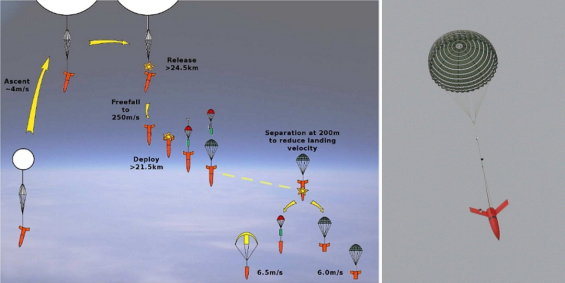EDM Parachute System Tests
Following the entry phase, the EDM flies at a velocity of up to Mach 2 (about 470 metres per second) and must decelerate to roughly 80 metres per second and be stabilised by its parachute system during its descent through the Martian atmosphere. The parachute system will also provide sufficient deceleration to ensure that the front shield separates safely.
The parachute system has three main components: the parachute, the parachute deployment device, and the cover.
The 12-metre diameter parachute design is derived from the parachute designed for the Huygens mission and is optimised to operate at supersonic speeds. The parachute itself will deploy while the EDM travels at between Mach 1.6 and 2.1. During the Huygens development, the parachute’s performance was already tested up to Mach 1.5 and the EDM development wind tunnel tests will extend the tested Mach range, up to Mach 2.1. The distance between the parachute and the descent module will be roughly 27 metres.
Since the beginning of the development of ExoMars, several tests have been performed, first on the materials selected for the parachute fabric and lines and then, to test its performance with the following test methods:
- Extraction tests: to test the extraction of the parachute from its storage bag and deployment
- High-altitude drop tests: to test the inflation of the parachute and its descent from an instrumented drop test vehicle
Extraction Tests
The parachute will be stowed in a dedicated bag during the cruise to Mars, and will be deployed by a pyrotechnic mortar that will eject the bag with a velocity of roughly 30 metres per second. The method of folding the parachute and the cords in the storage bag is done via a special process to ensure that it is extracted successfully.
Tests were performed in representative dynamic conditions to verify that the parachute would be extracted correctly.
| Parachute extraction tests at AeroSekur facility, Aprilia, Italy. Credit: AeroSekur Follow the links for more information on the left video and the right video |
|
High Altitude Drop Tests
The low atmospheric pressure on Mars, less than 1/100 of standard atmospheric pressure on Earth, could prevent the parachute canopy from inflating properly. It is possible to study this in detail at roughly 30 km altitude on Earth, where atmospheric pressure conditions match those on Mars. This is done using a stratospheric balloon which carries the parachute system stowed inside a rocket-shaped test vehicle and drops it at the required altitude.
 |
| Sub-scale high-altitude drop test. Credit: CUSF, Vorticity |
To assess this method, a sub-scale test was performed in England using a 2.5-metre diameter parachute model. This drop test allowed assessment of the techniques and measurement systems that will be used in the forthcoming full-scale high-altitude drop test scheduled for mid-2012 at the Esrange Space Center in Sweden.
| Sub-scale parachute high-altitude drop test. Credit: CUSF, Vorticity Click here for more information on this video |
The parachute test activities are carried out by Thales Alenia Space, France, and AeroSekur, led by Thales Alenia Space - Italy, including key contributions from Vorticity Ltd. and Cambridge University (sub-scale high altitude drop tests) and CNES / Swedish Space Corporation (full-scale high altitude drop tests to be performed in 2012), under the close supervision of ESA.
